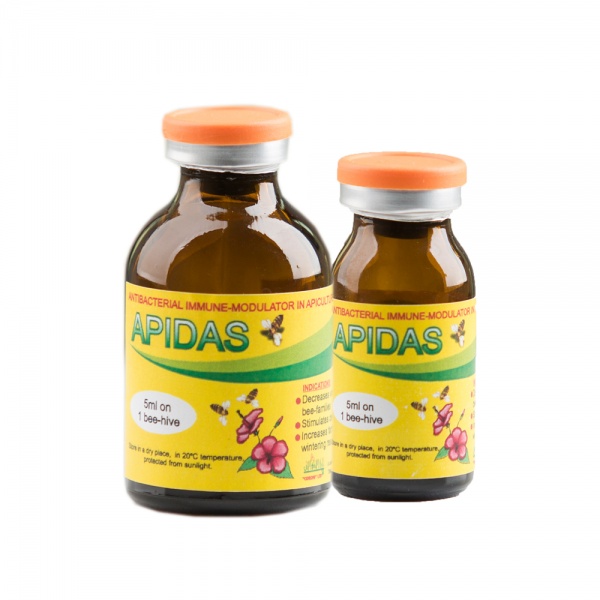APIDAS
CORONI, Georgia
Description:
Yellow or brown solution with strong smell
Composition:
Nanopeptide-amino-vitcarbone-800
Characteristics:
Apidas is characterized with bactericide, fungicide and atni-protozoa activities. Its characteristics are determined by complicated complex of biologically active substances, micro and macro elements it contains. As a food additive it stimulated development of bee families, activates egg-laying by mother bees and production of bee milk, increases family productivity, improves wintering results. Its biologically active components stimulate bee immunity, decreases diseases caused by virus and bacteria infections.
Usage:
Apidas is used against fungi and bacteria infections (ascopherosis, aspergilosis, American and European putridity, para-putridity, paratyphus, hafniosis, colibacteriosis, and septicemia) for treatment of bee nozematosis, and for preventive reasons as well. It is used in spring for development of bee families. Apidas is used for prevention of infective diseases among bee families, stimulation of be development and increasing of immunity in autumn. It is used as soon as disease symptoms are revealed.
Dosage
1. Apidas is used by adding to 50% sugar syrup. Treatment syrup is prepared by solution of 5 ml (1 vial - 100ml) of food-additive with 150 sugar syrup for one bee-hive. Bees are fed by treatment syrup or it is poured in empty cells, which is placed in bee nest. It is enough to give treatment sugar syrup once for prevention purposes. For treatment of nozematosis, syrup is given twice with three days of interval. In case of infective diseases it is given with 3 days of interval until complete disappearance of disease symptoms. Last treatment is given in 3-4 days after disappearing of disease symptoms.
2. Bees are fed by treatment caramel. Treatment caramel is prepared by mixing 500gr of caramel with 5ml of Apidas.
3. Caramel expenditure for 1 frame that is densely covered by bees is 50 grams. It is enough to use given caramel once for prevention. For treatment of bees with nozematosis caramel is given once, 50-60 grams for 1 frame that is densely covered by bees. Given mixture is used against infective diseases with intervals of 6-7 days, with 50 grams of substance for 1 frame that is densely covered by bees. Treatment feeding is carried out until all signs of disease disappear completely. Final feeding is carried out for 5-6 days, when disease symptoms completely disappear.
4. As a water solution it is spread over cells with narrow holed spray (‘Rosinka" etc). Solution is prepared by diluting of 5 ml of Apidas with 100ml warm boiled water (40-500C). Working solution is cooled to the room temperature and is sprayed over bee cells - 10ml on 1 frame densely covered with bees. For prevention it is enough to spray given solution only once. For treatment of bees with infective diseases it is sprayed with intervals of 3-4 days until complete disappearance of signs of disease. Final spraying is carried out within 3-4 days after complete disappearance of disease. This processing is carried twice with 3 days of intervals during curing of Nozematosis.
5. 5ml of Apidas is used for processing 10 frames densely covered with bees. Processing with working solution of given food-additive is carried out at least on the temperature of 150C.
6. Please follow recommendations regarding working solution concentrations of Apidas during every kind of bee processing and its dosage on 1 frame densely covered with bees.
Advantages:
High effectiveness of Apidas against wide spectrum of diseases of bee families gives an opportunity to prevent infections and ensures getting of high quality and ecologically clean products.

